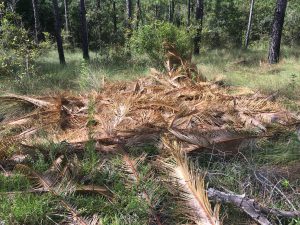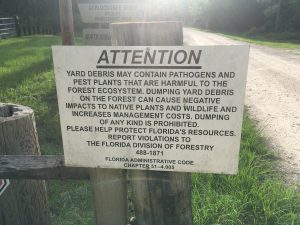As a compost fanatic, one of my favorite Florida-Friendly Landscaping principles is Recycle Yard Waste – Principle #7. Since the practice of gardening typically leads to various debris, including herbaceous weeds, lawn clippings, woody stems after pruning, and just the leaves that fall from your trees, gardeners must somehow manage all of this material.
Rather than tossing it to the curb, where it goes to the landfill and very slowly breaks down in anoxic conditions (lacking oxygen) leading to increased methane emission, a more sustainable approach is to utilize these materials on site. On-site recycling of garden debris can be done through, my favorite, composting, especially when dealing with herbaceous material.
Grass clippings are best left on the grass, as long as not in excessive clumps. Woody debris can be piled in not-too-conspicuous areas to create brushpiles that will provide wildlife with cover. While many think of snakes and other creepy crawlies in piles of brush, many birds, lizards, mammals, insects, and fungi will call a brushpile home. Fallen leaves can be raked into garden beds to act as mulch, another Florida-Friendly Landscaping principle! Besides not using the energy required and creating the extra methane (a stronger greenhouse gas than carbon dioxide) produced by sending materials to the landfill, recycling materials on-site returns the nutrients in that debris to your soil for future plants to take up.
However, there is a fate of yard debris that is even worse than sending to the landfill (cue scary music) – illegally dumping the materials in a natural area!!

Landscape debris dumped in a natural area can spread invasive plants, insects, and disease. Credit: Mark Tancig.
You may have seen this in a local natural area you visit or heard of folks that try to skip paying solid waste fees by dumping it elsewhere. Unscrupulous landscape companies and homeowners have been known to do this, especially when the work site is near a large natural area, such as a state or national forest. The main problem with this, besides that it is illegal, is that invasive species can be spread with debris directly into a native forest. Invasive plants are documented to be spread in this manner, especially those that are easily rooted from stems. Additionally, illegal dumping of plant material can spread non-native fungi, insects, and animals into these areas and disrupt natural ecosystem functions and the organisms that rely on them.
Homeowners can make sure they don’t contribute to this problem by recycling as much on-site or properly following local guidelines to dispose of landscape debris. Many municipalities have separate bulk collections or drop-off sites for landscape materials. If hiring a landscape contractor, ask where they take the collected material and/or request that it stay on the property. For large jobs, such as tree removal, the estimate should reflect dump fees. If you notice materials dumped in a local natural area, report it to the land manager so they can investigate and/or clean it up and dispose of properly.
- When to Worry About Your Citrus During Cold Weather - December 18, 2025
- A Tale of Two Hoses - November 13, 2025
- Anthracnose and Aster Yellowing Diseases Recently Diagnosed - August 28, 2025

